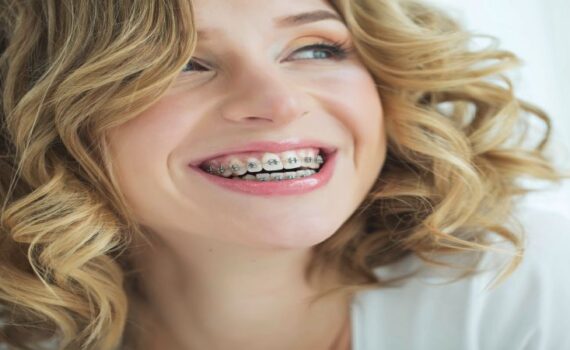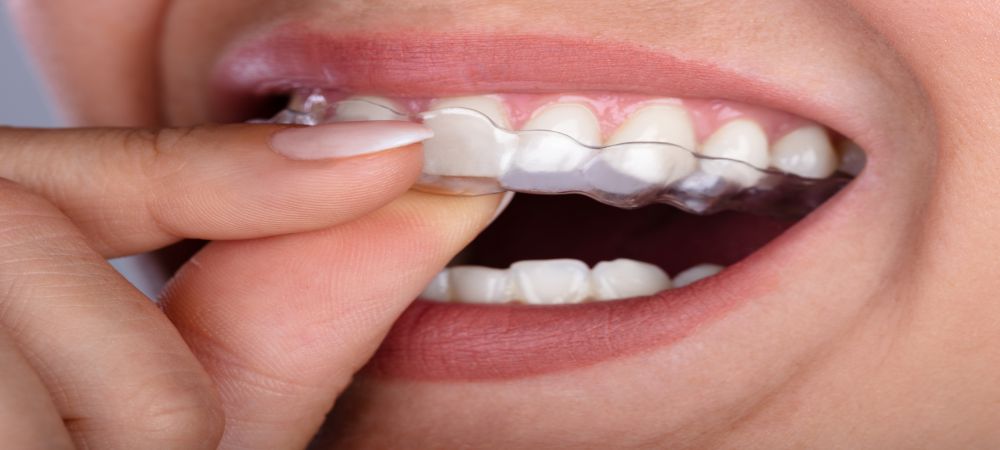We do not install braces in our clinic. We use Invisalign invisible aligners for bite treatment.
Only a select few are lucky enough to have a perfect set of teeth. This means that the majority of the population has to deal with crooked teeth, misalignment, and other issues, which can cause self-confidence to plummet. To make matters worse, these dental problems may also lead to pain, fatigue, and general discomfort if left untreated, significantly lowering the quality of life. And, this is where braces come in, and there are several types to choose from – you decide which one is best for you.
A perfect smile boosts your self-esteem, but that is not the only benefit of braces. It also improves your overall health and well-being.
There are several types of braces available – from traditional metal braces to innovative clear aligners. Your dental professional will help you decide which treatment method best fits your particular goals and needs. Below, we discuss the most popular options, including their pros and cons.
The Different Types of Dental Braces
These dental appliances are designed to correct a wide range of orthodontic problems, including:
- Overcrowded or unevenly spaced teeth
- Bite problems
- Misplaced dental midline
- Misaligned jaw
- Periodontal issues
- Chewing or speech difficulties
Essentially, braces work by straightening or moving your teeth to improve their appearance or overall function. This is done by applying pressure on the teeth, inducing them to move in the right direction. They may also need to be tightened or replaced periodically to work their magic. More importantly, these dental appliances promote the health of the teeth and gums, as well as make it more comfortable to bite and chew.
Dental braces have certainly come a long way. Gone are the days when your only option was metal braces. Now, there are different types of braces to choose from, depending on your dental problems and specific needs. As mentioned, each type has its respective advantages and disadvantages. For optimal results, make sure to assess and discuss every single one of them with your dentist or orthodontist.
Traditional metal braces are what immediately comes to mind at the mention of the word “braces.” Thanks to technological advancements, they have now become lighter and more comfortable than ever. Fashioned from high-grade stainless steel, metal braces typically consist of the following core components:
- Small, square brackets that are attached to the front of your teeth using a bonding agent.
- Orthodontic bands that wrap snugly around each tooth. (Note that not everyone will need bands.)
- Archwires that hold the brackets or bands together and in place.
Some braces may include removable elastics or rubber bands – which are not to be confused with orthodontic bands – that connect the brackets to the wire. This creates additional pressure to align your bite and straighten your teeth. In some cases, orthodontists may require you to wear orthodontic headgear at night to further correct your bite, as well as encourage proper jaw alignment and growth.
- Metal braces are the fastest and most effective way of correcting misalignments – including severe cases.
- While not exactly cheap, braces are still the least expensive option of the bunch.
- Metal braces are relatively easy to clean and maintain, keeping your teeth clean and your mouth feeling fresh at all times.
- Traditional braces are highly customizable. The bands come in a wide range of colours and are also interchangeable, which means that you could easily choose the colours that match your preferences and personal style.
- Metal braces may cause some discomfort. For instance, the brackets and wires might break or become too long, poking the inside of the cheeks or the gums.
- Of all the different options, metal braces are the most noticeable, causing some people to feel self-conscious about their physical appearance.
Metal braces are a great choice if you have severe alignment problems or suffer from extreme overcrowding. Plus, they are ideal if you want a tried-and-true option that delivers impressive results in the least possible time.
Ceramic braces are highly similar to traditional metal braces, particularly in terms of function and application. They are also affixed to the front of the teeth and primarily consist of brackets and wires. The main difference between the two is that ceramic braces, as the name suggests, boast tooth-colored ceramic brackets. On top of that, the wires can also be coloured, making them even less conspicuous.
- Ceramic braces are significantly less obvious than metal ones.
- Like traditional braces, ceramic braces can also rectify any misalignment issues at record speed.
- Ceramic braces are a little pricier than traditional braces.
- The ceramic material could become stained without proper dental habits, resulting in an unsightly appearance.
- They are more fragile than regular braces and may require extra care and maintenance to remain in good condition.
- Since ceramic braces also use metal wires, they could also produce some slight discomfort when worn.
Ceramic braces are the way to go if you want the supreme functionality and reliability of traditional braces but prefer something more discreet.
Lingual braces are completely different from metal and ceramic braces. This is because they are attached to the back of the teeth instead of the front, making them practically invisible to others when you smile. They are also made of stainless steel, with the entire metal appliance customized to meet your specific needs and match the shape of your teeth.
- Since lingual braces are not easily seen from the outside, they are ideal for patients with cosmetic concerns. This includes models, actors and actresses, musicians who play wind instruments, or any other individuals who dislike the appearance of traditional braces.
- If lingual braces are appropriate for your case, they can address misalignment problems relatively quickly.
- Lingual braces are generally less effective than traditional metal braces and often take a longer time to produce the desired results.
- While lingual braces can typically correct the same kinds of alignment concerns as regular braces, they are still not suitable for all orthodontic issues.
- Lingual braces tend to be more expensive than metal and ceramic braces. This is because they usually require individual customization to guarantee a snug fit, which could rack up the costs.
- Since they come into direct contact with the tongue, lingual braces can be more uncomfortable than braces that are fastened in front of the teeth.
- Due to their placement at the back of the teeth, lingual braces can be more challenging to clean than ceramic or metal braces.
Lingual braces are perfect if you want to hide your braces from plain sight and have some extra bucks to spare.
Clear aligners – sometimes referred to as invisible braces – are clear plastic trays that fit snugly over your teeth. They resemble thin mouth guards and are practically invisible to the people around you – hence the name. Unlike the other types of braces in this list, clear plastic aligners are not permanently secured into place. Instead, they are removable and taken out when eating, drinking, brushing, or flossing. However, keep in mind that they need to be worn for at least 22 hours each day to be effective.
Invisalign is by far the most well-known producer of clear braces, but other reputable brands exist, including ClearCorrect, SmileDirectClub, and Candid.
- Clear braces are discreet and virtually imperceptible.
- This type of brace enables you to eat and drink without any discomforts – and with fewer restrictions on the food options.
- Being removable, invisible braces are effortless to clean.
- Unlike braces with metal components, clear plastic aligners will neither irritate the insides of your cheeks nor cause mouth sores.
- Invisible braces are only suitable for mild to moderate misalignments in teenagers and adults.
- Clear aligners are not as effective as traditional braces, especially in certain cases.
- It is the most expensive brace option in the market.
- The plastic trays can become stained or damaged without proper care and maintenance.
Clear aligners are a fantastic choice if you want an unobtrusive type of brace but without the pain and discomfort associated with lingual braces. It is also recommended if you want something that is removable for added convenience. Again, it is ideal if you are willing to shell out more money than usual.
The Best Braces for Your Needs
Many people, regardless of age, will need a brace at a point in their lives. It might sound like a hassle, but there is no better time to have braces than now. Before, wearing braces means having a mouth full of metal appliances – but not anymore. Today, there is a wide array of dental braces at your fingertips – from the tried-and-tested metal braces to more unorthodox options. Keep in mind that one is not better than the other. It all comes down to your individual needs, preferences, and budget.
For more severe dental problems, metal and ceramic braces are the way to go. They are extremely effective, producing substantial results much faster than other methods. They are also ideal if you are looking to save up on costs, even if just a little. Of the two, traditional braces are much easier to maintain and keep clean. Just be aware that you may experience some discomfort while wearing any of these braces.
Meanwhile, if you have aesthetic concerns, you will not go wrong with ceramic braces, lingual braces, and invisible aligners. However, the last two are among the priciest options. But for many, it is a small price to pay for the comfort and convenience they will bring.
In the end, what is important is that you follow your dental professional’s advice to the letter. This includes avoiding certain foods, practicing good oral hygiene, and not missing your checkups or appointments with a cosmetic dentist in Fort Lauderdale. This way, you can make the most out of your braces and show off those perfect teeth in no time.





